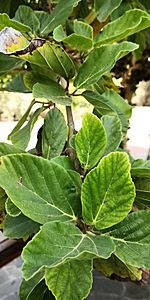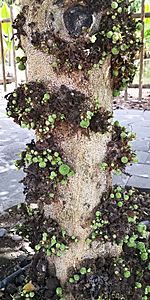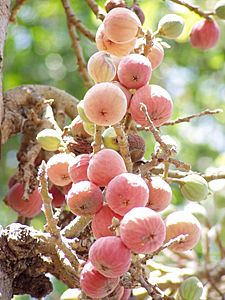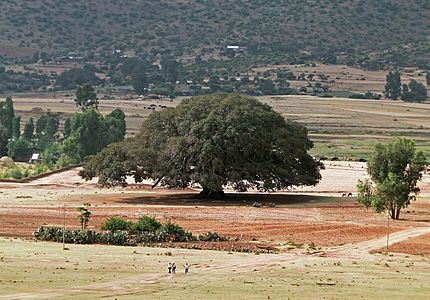Ficus sycomorus facts for kids
Quick facts for kids Ficus sycomorus |
|
|---|---|
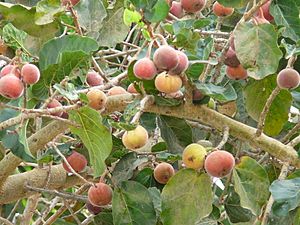 |
|
| Leaves and syconia of Ficus sycomorus | |
| Conservation status | |
| Scientific classification | |
| Genus: |
Ficus (plant)
|
| Species: |
sycomorus
|
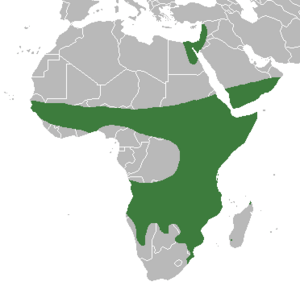 |
|
The Ficus sycomorus, often called the sycamore fig or fig-mulberry, is a type of fig tree. People have grown this tree for a very long time, since ancient times! Its leaves look a bit like those of a mulberry tree, which is why it's sometimes called the fig-mulberry.
It's important to know that the word "sycamore" can also refer to other trees, like the Great Maple (Acer pseudoplatanus) or plane trees (Platanus). To be super clear about Ficus sycomorus, some people spell it "sycomore" with an 'o'.
Contents
Where the Sycamore Fig Grows
The sycamore fig is originally from Africa. You can find it south of the Sahel desert and north of the Tropic of Capricorn. It doesn't grow in the central-west rainforests. This tree also grows naturally in places like Lebanon, the southern Arabian Peninsula, Cyprus, and parts of Madagascar. You can also find it in Israel, Palestine, and Egypt.
In its natural home, the sycamore fig usually grows in rich soil. It likes to be near rivers and in mixed forests.
What the Sycamore Fig Looks Like
The sycamore fig tree can grow quite tall, up to 20 meters (about 65 feet). It has a wide spread with a thick, round top made of many branches.
Its leaves are shaped like a heart with a rounded tip. They are about 14 cm (5.5 inches) long and 10 cm (4 inches) wide. The leaves grow in a spiral pattern around the branch. The top of the leaves is dark green, and the bottom is lighter with clear yellow veins. Both sides feel rough if you touch them.
The fruit of the sycamore fig is a large, edible fig. Each fig is about 2–3 cm (1–1.2 inches) across. They change color as they ripen, from a greenish-yellow to yellow or red. These figs grow in thick groups on long small branches or where the leaves meet the main branch. You can find fruit on the tree all year round, but most of them ripen between July and December.
The bark of the tree is green-yellow to orange. It peels off in thin, papery strips, showing the yellow bark underneath. Like all fig trees, it has a milky liquid called latex inside.
How People Grow Sycamore Figs
Historians and botanists believe that the ancient Egyptians grew the sycamore fig "almost exclusively." This means it was one of their most important trees! We know this because parts of the sycamore fig, like its fruit and wood, have been found in very old Egyptian sites. They appear a lot from around 3000 BC. The ancient Egyptians even thought of it as their "Tree of Life."
Many pieces of the dried fruit, called sycons, found in tombs have special cut marks. This shows that the Egyptians knew how to cut the fruit to help it ripen faster, even thousands of years ago.
For the sycamore fig to make seeds and reproduce, it needs a special tiny wasp called Ceratosolen arabicus. This wasp helps the tree pollinate. Even though this wasp is no longer found in Egypt, experts believe Egypt was the main place where the sycamore fig was first grown a lot. Some of the wooden boxes used for mummies in Egypt were even made from this tree's wood.
In tropical areas where the wasp lives, the sycamore fig tree is part of a complex mini-ecosystem. The tree produces fruit all the time, which means insects and animals are always around it, creating a lively environment.
Sycamore Figs in Gardens
In the Near East, the sycamore fig is a very important tree for orchards and as an ornamental tree in gardens. It has wide branches that spread out, making it a great shade tree to relax under.
The Sycamore Fig in Religion
The sycamore fig is mentioned several times in important religious texts.
In the Bible
The sycamore fig is mentioned in both the Old and New Testaments of the Bible. Even though it wasn't as common everywhere in Palestine, it was a very popular and valuable fruit tree in places like Jericho and Canaan.
- In the Book of Psalms, sycamore figs are listed as food sources that were destroyed during the plagues in Egypt. This suggests they couldn't survive in colder, mountainous areas.
- King David had an officer whose job was to look after the olive and sycamore trees in the western hills.
- King Solomon made valuable cedar wood as common as sycamore wood, showing how common sycamore was.
- The prophet Isaiah compared sycamores and cedars when talking about his people's pride.
- The prophet Amos said he was a "dresser" or "tender" of sycamores. This job involved cutting the fruits to help them ripen.
- In the New Testament, in Luke's Gospel, a man named Zacchaeus climbed a sycamore tree in Jericho to get a better view of Jesus.
In Other Religions
For the Kikuyu Religion in Africa, the sycamore fig, known as "mugumo," is a sacred tree. All important sacrifices to Ngai, their supreme creator, were performed under this tree. If a mugumo tree fell, it was seen as a bad sign. Elders would then perform special ceremonies. Some of these ceremonies are still practiced today.
Gallery
See also
 In Spanish: Sicomoro para niños
In Spanish: Sicomoro para niños



